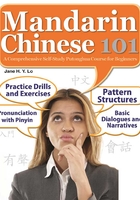
How to use this book
“Mandarin Chinese 101” is a teach-yourself textbook. It consists of twenty lessons, and each lesson includes the following parts:
1. Pronunciation
Lessons 1 to 5 deal with Chinese pronunciation. In order to help foreign learners pronounce initials, finals and tones accurately and easily, each initial and final is compared with a similar sound in English. This approach has been adopted with the aim of enabling learners to read Pinyin without assistance. They can imitate and pronounce each final and initial confidently, even without the guidance of a teacher. With careful practice and repetition of the sounds presented in each lesson, learners will find their pronunciation becoming increasingly accurate.
2. Dialogues and passages
In lessons 6 to 13 there are two dialogues in each lesson; lessons 14 to 20 have one dialogue and one narrative. Each dialogue or narrative is followed by questions. The aim is comprehensive language practice, providing the learners with opportunities to practise and repeat active words, useful phrases and patterns that are important in daily conversation. This kind of training enables the learners to do oral practice and thus improve their ability to communicate in Mandarin.
The dialogues cover different subjects, such as family, sports, food, seeing a doctor, marriage, and study, all of which may be useful or of interest to the learners. The purpose is to enable them to converse about similar subjects with a Mandarin speaker.
3. Pattern Structures
The grammar is presented in Pattern Structures, in order to make the grammar points easier for learners to memorize and understand. Each Pattern Structure is followed by substitution exercises and pattern drills. The purpose of these exercises is to lay a solid foundation for further study of Mandarin.
Each lesson finishes with ten or more English sentences for translation into Pinyin. These are designed to consolidate the grammar structures, useful idioms and phrases.
4. Notes
There are Notes following each dialogue and narrative. They explain difficult sentences and expressions, give additional explanations about grammar points and certain pattern structures and ensure the learner thoroughly understands the dialogues and narratives.